I get asked all the time,
"What is dry needling?"
"Have you heard of dry needling?"
"Can you do dry needling?"
"I got dry needling done at another location, can we do that today?"
I've found that not only am I regularly explaining dry needling to patients, but those certified in it are often equally as confused, (and there's a reason for that).
Let me break it down for you.
Dry Needling Basics
Dry needling was established in the 80s and is called "dry needling" to differentiate it from "wet needling" or using a hollow needle for fluids and injections.
Dry needling uses acupuncture needles and was taught to chiropractors and physical therapists, who utilized it before it was legally in their scope of practice. (PTs weren't able to legally perform dry needling until 2017).
The certification process in IL takes about 100 hours, only about half of which is hands-on needling training. This is part of why it has such a limited scope and ability compared to acupuncture. It can only address muscle pain and the needles are used to cause a muscle spasm which releases potential trigger points.
Here's the complicated part.
The language used to certify dry needling training varies, and some courses in dry needling do call it acupuncture. So even chiropractors who are not licensed acupuncturists are "certified in acupuncture", and are led to believe they can offer acupuncture services.
They are not acupuncturists.
Acupuncture Basics
Acupuncture has been an effective medical therapy for thousands of years, addressing pain of all origins, internal medicine, and even psycho emotional disorders. To become a licensed acupuncturist, it requires a Masters or Doctorate degree in Science and Chinese Medicine, usually taking 5 years and thousands of hours of hands-on clinical hours to complete.
It then requires 4 board exams and a separate training to maintain a clean field, (a sterile environment to prevent the spread of disease).
During training, acupuncturists gain the ability to read labs, perform orthopedic exams, understand pharmaceutical interactions, as well as attain in depth knowledge of the body and Chinese medical system, including hundreds of points and herbs, anatomy and Eastern and Western diagnostic theory.
Because of our intensive training, all acupuncturists can perorm dry needling. It came from acupuncture, using the simple concept of "it hurts I'll put a needle there." (It's an effective strrategy).
In Chinese, these points are called "Ah Shi" points, a term that's been around for thousands of years. It means, "ah, yes!" Something we all say when someone finds out painful spots. These are the same areas needled in dry needling protocols.
In short, dry needling is acupuncture. It's a sliver of what acupuncturists can do.
It uses acupuncture tools and acupuncture points, but not acupuncture training, and is not acupuncture, as done by an acupuncturist.
For more information on the subject, here are some helpful articles and resources:
FAQ | Indiana Society of Acupuncturists (indianaacupuncturists.org)
Dry Needling is Acupuncture - AWM (asacu.org)
Dry Needling is Acupuncture: Anatomy of a Legal Victory in Oregon (acupuncturetoday.com)
For information on dry needling training requirements from the IL Chiropractic Society:
FAQ: Is Dry Needling in the Scope of Chiropractic Practice? - Illinois Chiropractic Society (ilchiro.org)
Dry Needling Legislation Update - Illinois Physical Therapy Association (ipta.org)




